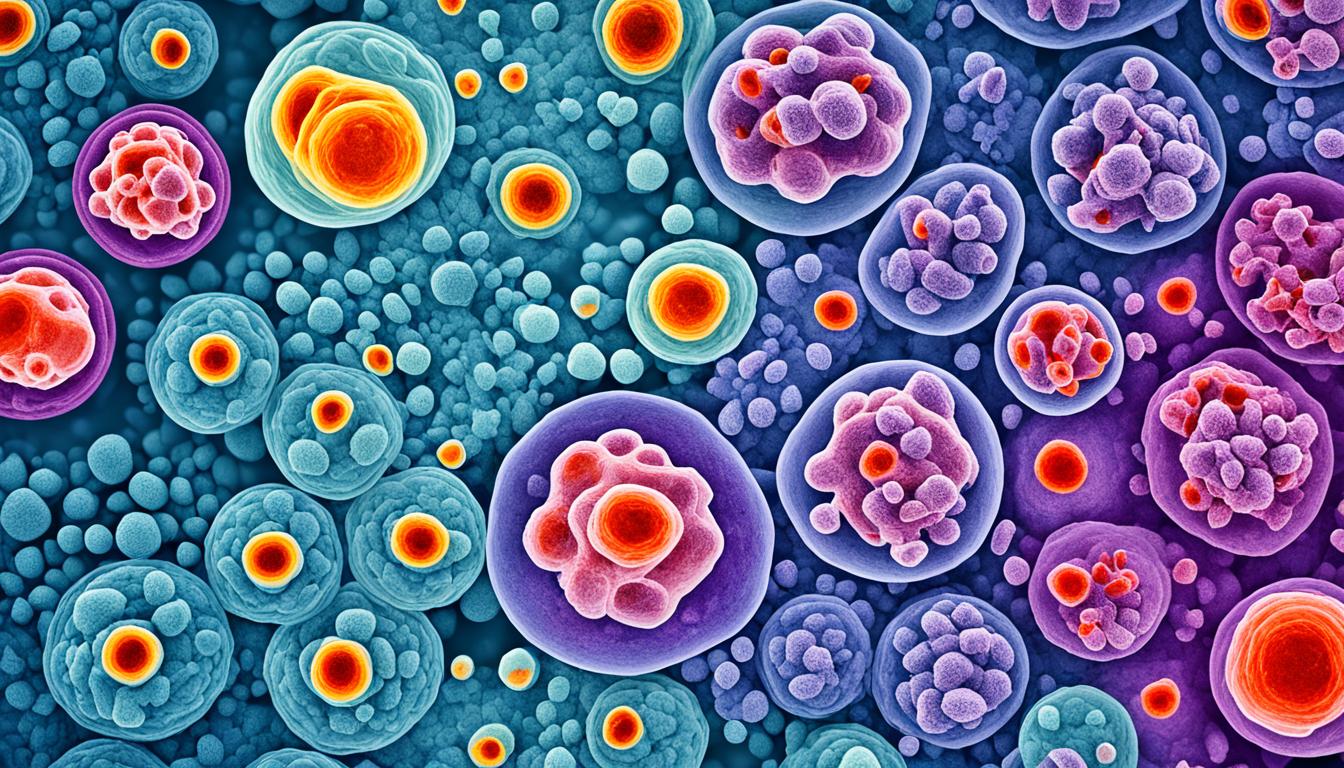Neuroblastoma is a childhood cancer that usually shows up before age 5. It starts in the nervous system or adrenal glands, often in the belly or chest. Doctors don’t always know what causes it, but they think genes and things moms are around during pregnancy might play a part.
The signs of neuroblastoma change based on where the tumor is. A big bump in the belly, shaky eyes, pee problems, feeling achy, and having a fever are common. To find out if it’s neuroblastoma, doctors use pictures like ultrasounds and CT scans. They also take tiny pieces of tissue to look at under a microscope.
How they treat neuroblastoma depends on the child’s age and how bad the cancer is. Healing might come from operations, drugs like chemotherapy, or high-energy X-rays called radiation. There’s also a new way using stem cells that scientists are very interested in. It could make a big difference.
Key Takeaways:
- Neuroblastoma is a childhood cancer that affects kids under 5.
- It starts in the nervous system or adrenal glands, usually in the belly or chest.
- The exact cause of neuroblastoma is not fully known, but genes and pregnancy exposures are looked at closely.
- Symptoms include a belly lump, shaky eyes, pee problems, aches, and fever.
- Finding out is through scans and tests on tissue for specific cells.
- Treatments may involve surgery, drugs, radiation, and cutting-edge stem cell approaches.
Neuroblastoma Research and Prognosis
Experts are always studying how to treat neuroblastoma better and with fewer side effects. This keeps neuroblastoma research a very active field.
How well someone does with neuroblastoma varies. It depends on things like how severe the cancer is, what the tumor is like, and how they respond to treatment.
Children with low-risk neuroblastoma – those at stages 1 or 2 – have a very high chance of living long term. Their rate of survival is over 90%. However, those with more serious stages face lower chances of survival, even with aggressive treatments.
Doctors tackle neuroblastoma with a range of treatments. This includes surgery, chemotherapy, radiation therapy, and more. The goal is to fight the cancer effectively and increase survival chances.
After treatment, regular check-ups are vital. They make sure the cancer stays away and help manage any long-term effects.
Advancements in Neuroblastoma Research
Neuroblastoma research moves fast, with new studies always on the horizon. These efforts are geared toward better treatments and knowledge. The aim is to improve patient lives and lessen the impact of treatments are the main goals.
The focus is on targeted and personalized treatments. These methods aim to attack cancer while protecting healthy cells.
Immunotherapy also holds promise. It spurs the body’s immune system to fight the cancer better.
Promising Research Initiatives
Different groups also support neuroblastoma research. The Neuroblastoma Research Foundation is one example. It funds studies that aim to understand and treat neuroblastoma better.
The Children’s Oncology Group runs big tests on the best treatments. These efforts are key to improving care for kids with neuroblastoma.
Multi-group efforts are vital. They connect researchers, doctors, and drug makers. This teamwork is essential for real progress in neuroblastoma fighting.
Neuroblastoma Diagnosis and Stages
Diagnosing neuroblastoma needs a thorough checkup. It involves medical exams, blood and urine tests, and imaging like CT scans. There’s also a detailed look at the bone marrow.
Staging helps doctors figure out how far the disease has spread. The International Neuroblastoma Staging System (INSS) places neuroblastoma into stages depending on where the tumor is and if it has spread. For instance, stage 1 means the tumor hasn’t spread much, and in stage 2, it might have reached the lymph nodes.
Stage 3 involves more spread, across the midline or to lymph nodes on the opposite side. Stage 4 means the disease has traveled to other parts like the liver or skin. For kids under 1, stage 4S shows a more limited spread to places like the liver, but not the bones.

